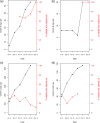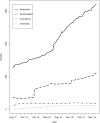Measuring engagement in a collaborative learning health system: The case of ImproveCareNow
- PMID: 33889734
- PMCID: PMC8051351
- DOI: 10.1002/lrh2.10225
Measuring engagement in a collaborative learning health system: The case of ImproveCareNow
Abstract
Background: Collaborative learning health systems have demonstrated improved outcomes for a range of different chronic conditions. Patient and healthcare provider engagement in these systems is thought to be associated with improved outcomes. We have adapted an observational framework to measure, and track over time, engagement in ImproveCareNow, a collaborative learning health system for children with inflammatory bowel disease.
Introduction: We developed a categorical classification scheme for engagement in ImproveCareNow. Each tier is defined in terms of observable individual behaviors. When an individual completes one or more qualifying behavior, s/he is classified as engaged at that tier. Individuals are entered into a database, which is accessible to care centers throughout the ImproveCareNow network. Database records include fields for individual name, behavior type, time, place, and level of engagement.
Results: The resulting system is employed at 79 ImproveCareNow care centers in the United States. The system recognizes four levels of engagement. Behaviors are recorded in a managed vocabulary and recorded in an online database. The database is queried weekly for individual engagement behaviors, which are tracked longitudinally. Center- and network-level statistics are generated and disseminated to stakeholders.
Conclusion: It is possible to monitor longitudinal engagement in a collaborative learning health system, thereby charting progress toward engagement goals and enabling quantitative evaluation of interventions aimed at increasing engagement.
Keywords: collaboration; engagement; measurement; pediatrics.
© 2020 The Authors. Learning Health Systems published by Wiley Periodicals LLC on behalf of the University of Michigan.
Conflict of interest statement
Michael Seid and Peter A. Margolis declare a financial interest in intellectual property licensed by CCHMC to Hive Networks, a company developing information technology to support collaborative learning health systems. Authors David M. Hartley, Christian Keck, and Mary Havens declare that they have no conflicts of interest.
Figures



References
-
- Olsen L, Aisner D, McGinnis J, eds. The Learning Healthcare System: Workshop Summary (IOM Roundtable on Evidence‐Based Medicine). Washington DC: National Academies Press; 2007. - PubMed
-
- Shah SL, Siegel CA. Increasing patient activation could improve outcomes for patients with inflammatory bowel disease. Inflamm Bowel Dis. 2015;21(12):2975‐2978. - PubMed
Grants and funding
LinkOut - more resources
Full Text Sources

